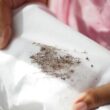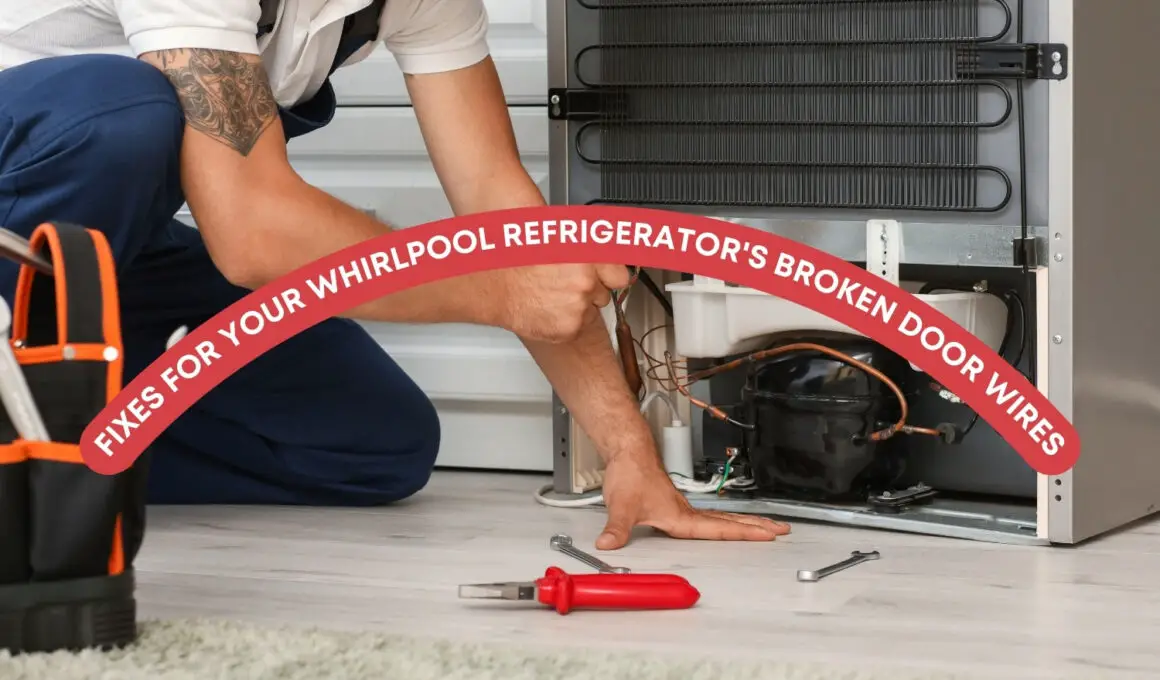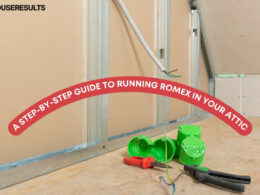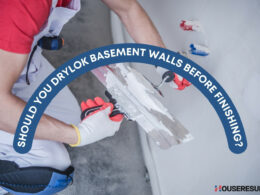Table of Contents Show
If you’re reading this, you’re likely grappling with some pesky door wire issues on your Whirlpool refrigerator. I’ve been there, both as a homeowner and as a contractor with a track record of helping countless homeowners like you fix similar issues.
Over the years, I’ve come to understand the importance of those little wires, especially in a reputable brand like Whirlpool.
These door wires might seem insignificant, but they play a crucial role in the overall functionality of your refrigerator. Broken wires can lead to a range of problems, from the inside light not coming on to troubling temperature inconsistencies.
But don’t fret; with the right approach, fixing these issues can be straightforward. Through this article, I aim to guide you with simple, professional, and effective fixes for your Whirlpool refrigerator’s broken door wires.
Common Issues with Whirlpool Refrigerator Door Wires
Whirlpool refrigerators, renowned for their durability and efficiency, sometimes face issues common to most household appliances, especially when it comes to door wires. Let’s talk about some of the typical troubles homeowners encounter with these doorwires.
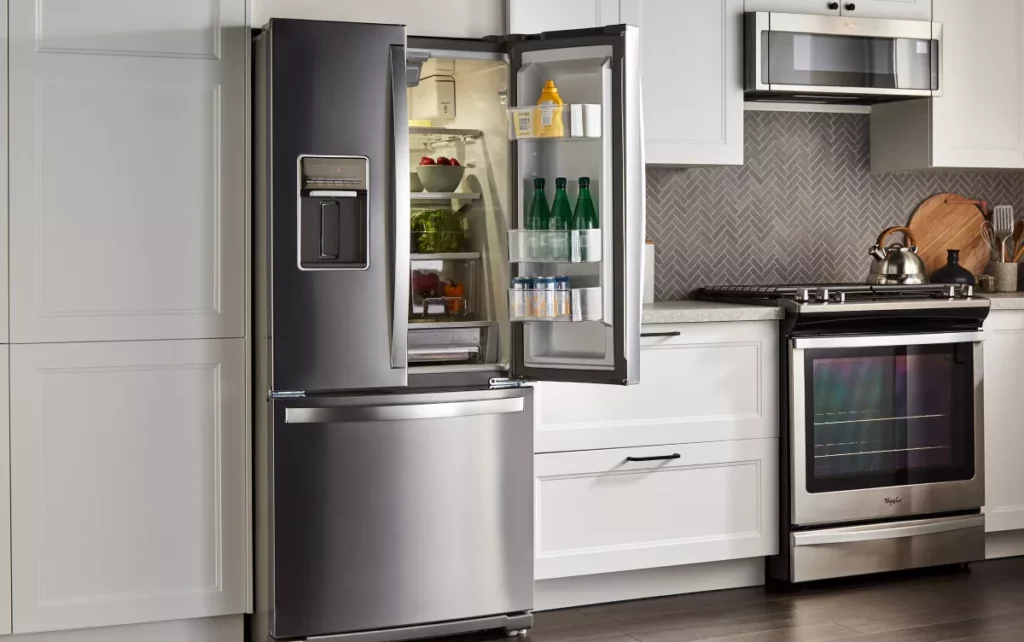
1. Wire Fraying or Cuts
Regular use, coupled with the constant opening and closing of the refrigerator door, can lead to wear and tear on the wires. Over time, this wear can manifest as frayed wires or even visible cuts. These damages can hinder the seamless transmission of electrical signals, leading to performance issues.
2. Disconnections or Loose Connections
The connectors holding the wires in place can become loose over time. This might be due to factors like temperature changes, physical disturbances, or just the age of the refrigerator. When wires aren’t securely connected, it disrupts the flow of electricity and can cause components linked to those wires to malfunction.
3. Symptoms of Broken Door Wires
A few clear signs indicate that the door wires might be compromised:
- Interior Light Not Working: The bulb is fine, but it won’t light up. Broken door wires might be the culprit.
- Temperature Fluctuations: If your fridge isn’t staying as cool as it should or is becoming too cold, damaged door wires affecting the sensors could be the reason.
According to a study published in the Academic Journal, regular maintenance and visual inspections of refrigerator components, especially wiring, can significantly reduce the risk of unexpected breakdowns.
This highlights the importance of being proactive about spotting and addressing wire-related issues in refrigerators. Keeping a keen eye out for these problems can save you from more significant complications in the future and ensure that your Whirlpool refrigerator remains in optimal condition.
Safety First: Precautions to Take Before Repairing
Before we jump into the actual repair process, it’s paramount to prioritize safety. Just like any other repair job, addressing issues with your Whirlpool refrigerator’s door wires comes with its own set of precautions. Here’s what you need to keep in mind:
1. Unplugging the Refrigerator
This might seem obvious, but it’s surprising how many folks overlook this step in the rush to fix the problem. Always, and I mean always, unplug your refrigerator before starting any repair work. Electricity is nothing to mess around with, and unplugging ensures you’re not working on a live circuit.
2. Using Gloves and Safety Glasses
Wearing protective gear can make a world of difference. Gloves not only protect your hands from sharp wire ends but also ensure you don’t inadvertently transfer any oils or contaminants to electrical components. Safety glasses shield your eyes from any unexpected sparks or debris. Think of them as your first line of defense against potential hazards.
3. Being Cautious of Sharp Edges
Refrigerator compartments and doors might have some unexpectedly sharp edges. When reaching in to inspect or repair wires, be mindful of these areas to avoid any cuts or scrapes. It’s always better to approach with caution than to rush and get hurt.
Remember, no matter how experienced you might be, never compromise on safety. It not only protects you but also ensures that your refrigerator is handled with the utmost care.
Effective Fixes for Your Whirlpool Refrigerator’s Broken Door Wires
Handling broken door wires can feel overwhelming, but with the right techniques and tools in hand, it becomes a manageable task. Here’s a step-by-step guide on how to tackle these issues:
1. Inspecting the Damage
Tools Needed
- Flashlight: For a clearer view inside the door compartments and other dimly lit areas.
- Magnifying Glass: Helps in closely examining any minute damages or issues with the wires.
Procedure
- With the refrigerator unplugged, open the door and locate the area where the wires are housed. This is typically at the hinge side of the door.
- Using the flashlight, illuminate the area to get a better view of the wires.
- Look for any visible signs of damage such as fraying, cuts, or disconnections. The magnifying glass can be handy here for a detailed inspection.
2. Reconnecting Loose Wires
Tools Needed
- Wire Connectors: To securely join two wire ends together.
- Wire Strippers: To expose fresh wire before connecting.
- Electrical Tape: For insulating any exposed wire sections.
Procedure
- Identify the loose wires that need reconnection.
- Use wire strippers to remove a small section of the insulation from both ends of the wire.
- Twist the stripped ends of the wires together.
- Place a wire connector over the twisted ends and twist it until it’s securely in place.
- Wrap the connection with electrical tape to ensure it’s insulated.
3. Replacing Frayed or Cut Wires
Tools Needed
- Replacement Wires: Ensure they match the gauge and type of the original wires.
- Wire Strippers: For preparing both old and new wire ends.
- Soldering Iron (optional): For a more secure connection, if you’re comfortable using it.
- Heat Shrink Tubing: To insulate the connection.
Procedure
- Determine the length of wire you need to replace and cut an appropriate length of the replacement wire.
- Strip the ends of both the old and replacement wires.
- Either twist the wires together or solder them for a more robust connection. If soldering, let the connection cool.
- Slide the heat shrink tubing over the connection and apply heat (a heat gun or even a hairdryer will work) until it shrinks snugly over the wire joint.
4. Securing the Wires
Tools Needed
- Cable Ties: For bundling and securing wires away from potential hazards.
- Adhesive Wire Clips: For holding individual or small groups of wires in place.
Procedure
- Once all repairs are done, it’s essential to ensure the wires are neatly organized and secured.
- Bundle any loose wires with cable ties, ensuring they aren’t overly tight.
- Use adhesive wire clips to position wires away from areas where they could get pinched or damaged, such as hinge mechanisms.
- Finally, make sure no wires obstruct any compartments or door closures.
By following these steps carefully, you can effectively address and fix issues related to your Whirlpool refrigerator’s door wires. Remember, the key is patience and ensuring that safety precautions are always followed.

Post-Repair Steps
After investing time and effort into fixing your Whirlpool refrigerator’s door wires, it’s essential to ensure that everything is functioning as it should. Addressing the immediate issues is just part of the process; what follows is equally crucial. Here’s what you need to do:
1. Testing the Refrigerator
Before you put all your tools away and consider the job done, it’s vital to test the refrigerator to ensure the repairs have been effective.
- Power Up: Plug the refrigerator back into the outlet. Listen for the familiar hum of the fridge starting up.
- Interior Light: Open the door and check if the interior light is functioning correctly. This is often directly related to door wire issues, so its proper functioning is a positive sign.
- Temperature Check: Set the refrigerator to its usual temperature settings. After a few hours, use a thermometer to ensure that the fridge and freezer are reaching the desired temperatures.
2. Monitoring for Irregularities
While an immediate test can give you a lot of confidence in your repair work, sometimes issues might crop up after prolonged use. Hence, it’s essential to be observant for a while.
- Daily Checks: For the next few days, pay closer attention to the refrigerator’s performance. Listen for any unusual sounds, check for temperature consistency, and ensure the door seals properly.
- Wire Inspection: After a week, it’s a good idea to inspect the repaired wires again. Ensure they remain secured and show no signs of new wear or damage.
- Note Any Anomalies: If you spot any irregularities, like frost buildup, temperature fluctuations, or condensation, they could be signs that something still isn’t right. Addressing these promptly can prevent further complications.
In the realm of DIY repairs, it’s not just about fixing the immediate issue but ensuring the longevity of the repair. With these post-repair steps, you’re not just resolving the broken door wire problem but ensuring that your Whirlpool refrigerator continues to serve you efficiently for a long time.
When to Call a Professional
While taking the DIY route can be both rewarding and cost-effective, there are situations where it’s best to call in the pros. Understanding when to step back and let a professional take over is crucial not just for the health of your refrigerator but also for safety reasons. Let’s delve into these situations:
Situations Where DIY Might Not Be Suitable
Complex Electrical Issues
If your Whirlpool refrigerator is displaying signs of significant electrical problems, such as frequent tripping of the circuit breaker, it’s best to get a professional involved. These could be indicators of more profound issues that a layperson might miss.
Coolant Leaks
Refrigerant leaks are not something to tackle on your own. They require specialized tools and knowledge to fix. Plus, refrigerants can be hazardous and are subject to environmental regulations.
Recurring Issues
If you’ve attempted a repair and the same problem keeps coming back, it’s a sign that there’s a deeper underlying issue. Instead of trying to fix it repeatedly, it’s wise to get expert insight.
Uncertainty
If, at any point, you feel uncertain or uncomfortable about a repair, it’s a clear sign to call a professional. It’s always better to err on the side of caution.
Benefits of Relying on a Certified Whirlpool Technician
Expertise
A certified technician will have extensive knowledge of Whirlpool products and can quickly diagnose and fix any issues. They’re trained to handle all potential problems and can provide insights that might not be apparent to the average homeowner.
Guaranteed Work
When a certified technician completes a repair, their work often comes with a guarantee. This means if the problem recurs or if there are issues related to the repair, they’ll address it without additional charges.
Safety
Professionals come equipped with the right tools and safety equipment, ensuring the job is done without risks.
Longevity
Technicians can not only fix the immediate problem but can also provide tips and advice on maintaining the appliance, ensuring its longevity.
Protection of Warranty
For those with refrigerators still under warranty, DIY repairs can void the warranty terms. In contrast, hiring a certified technician ensures that the warranty remains intact.
In conclusion, while DIY is an excellent option for many repairs, recognizing when it’s time to call in the experts can save you time, money, and potential headaches in the long run. Always prioritize the safety and the health of your appliance.
Maintenance Tips to Avoid Future Wire Damage
Ensuring the longevity of your Whirlpool refrigerator’s door wires doesn’t just stop at repairs. Adopting proactive maintenance habits can significantly reduce the chances of facing similar issues in the future. Here’s what you can do:
1. Regularly Inspecting the Wires
- Frequency: Aim to check the condition of the wires every 3-6 months. Regular inspections can help you spot potential problems before they escalate.
- What to Look For: Pay attention to signs of wear, such as fraying, discoloration, or any visible damage. Also, ensure that the wires are securely connected and are not hanging loose.
- Seasonal Check: If you live in an area with significant temperature fluctuations, it might be beneficial to inspect the wires as the seasons change. Extreme cold or heat can affect the wiring, so being vigilant can prevent damage.
2. Gentle Door Usage
- Avoid Slamming: Always close the refrigerator door gently. Slamming it can cause vibrations that might disturb the wires or their connections.
- Ensure Proper Sealing: When closing the door, make sure it seals properly without having to apply extra force. If you find you need to push harder than usual, it might be time to inspect the seals and the wires.
- Educate Family Members: Ensure that everyone in the household understands the importance of gentle door usage. A combined effort can go a long way in prolonging the life of the appliance.
3. Keeping the Hinge Areas Clean and Free from Debris
- Regular Cleaning: Dirt, grime, or food particles can accumulate in the hinge areas, leading to additional wear on the wires. Regularly wipe down these areas with a damp cloth.
- Check for Obstructions: Ensure that nothing is obstructing the hinge area, especially when you’re loading or unloading groceries. Even a small item can cause undue stress on the wires over time.
- Lubrication: Occasionally, lubricating the hinge can ensure smooth door movements, reducing the strain on the wires. Always use a lubricant that’s safe for kitchen appliances.
By integrating these simple maintenance tips into your routine, you can significantly extend the life of your Whirlpool refrigerator’s door wires. It’s all about adopting proactive habits and ensuring that minor issues are addressed promptly, preventing them from escalating into major problems.





